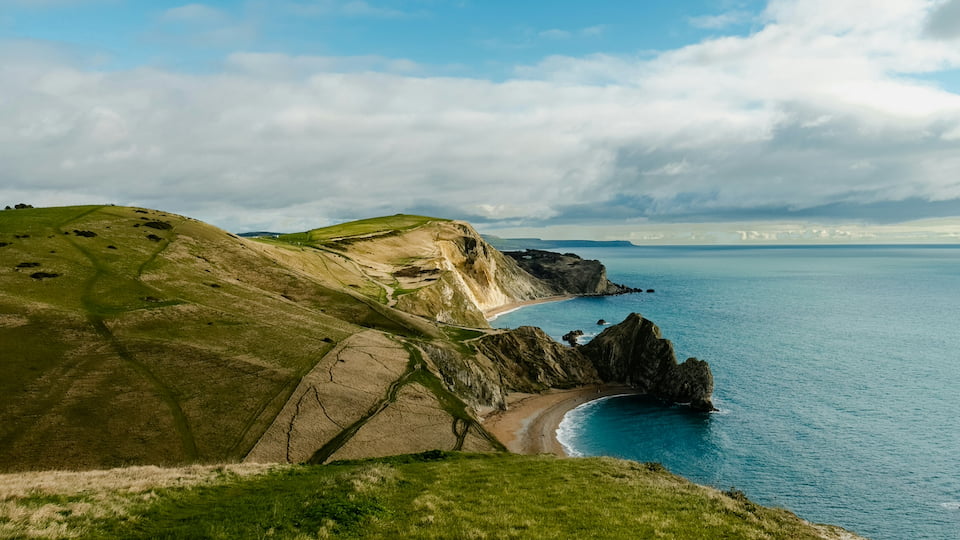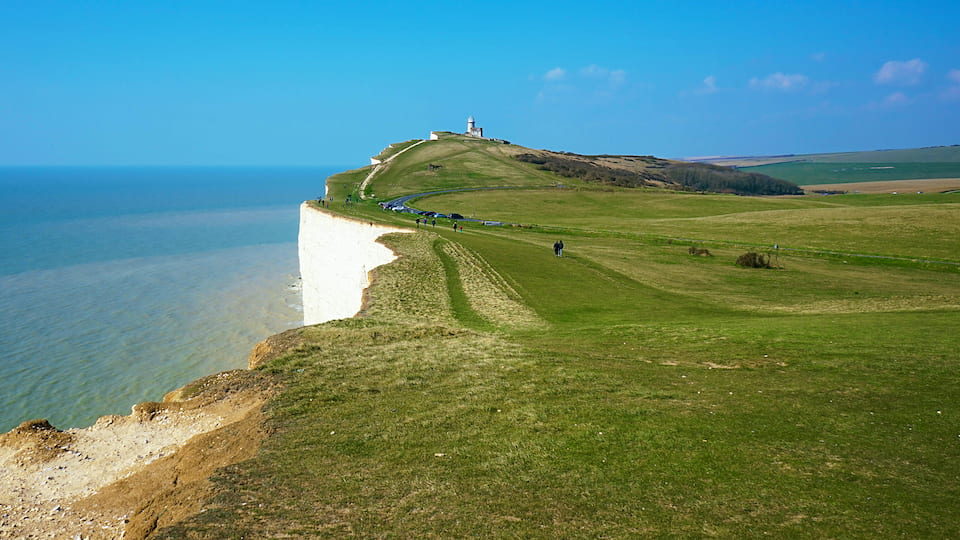10 Best Coastal Walks UK for Scenic Views and Fresh Air
Want some fresh air and a change of pace? There’s nothing quite like a coastal walk: the mix of sea breeze, wide-open skies, and paths that lead you past cliffs, coves, and fishing villages. Whether you’re after a gentle stroll or a longer challenge, the paths are waiting. Below, you’ll find ten of the best coastal walks UK has to offer, plus some handy tips to help you plan.
10 Best Coastal Walks Worth Trying in 2025
Whether you’re seeking dramatic cliffs, sandy stretches, or peaceful hideaways, these great coastal walks UK showcase the finest of Britain’s coastline:
1. St David’s Peninsula Circular Walk, Pembrokeshire
The Pembrokeshire Coast Path runs for 186 miles, but one of its most rewarding sections begins and ends in St Davids, the UK’s smallest city. This circular route loops around the peninsula, passing Iron Age forts, Celtic chapels, and quiet coves. Summer brings colourful wildflowers, while Whitesands Bay, a Blue Flag beach, is a highlight along the way. The walk finishes back in St Davids, with plenty of cafés and pubs to welcome tired legs.
Start/Finish: St Davids (circular route)
Distance: ~10.6 miles
Walking Time: 4.5–5 hours
Why it’s worth trying: This loop combines history, coastal scenery, and a charming town centre, all in one manageable day’s walk.
2. The Seven Sisters Coastal Walk, East Sussex
The Seven Sisters walk is perhaps the most iconic coastal route near London, known for its dramatic white cliffs, rolling hills and endless sea views. Despite the name, you’ll climb more than seven peaks between Seaford and Eastbourne, each one offering another breathtaking vista. Along the way, look out for Belle Tout and Beachy Head lighthouses, iconic landmarks on the southern coastline.
Starting Point: Seaford
Finishing Point: Eastbourne
Distance: ~13 miles
Walking Time: 6–7 hours
Why it’s worth trying: It’s one of the most iconic coastline walks UK hikers can tackle, challenging but unforgettable, with easy train links from London.

3. The Lizard Peninsula Circular Walk, Cornwall
The Lizard Peninsula marks mainland Britain’s most southerly point, and this walk captures its wild beauty. Starting at Kynance Cove, often ranked among Britain’s best beaches, the route passes Pentreath Beach, Lizard Point, and its lighthouse. The trail is dotted with seals, seabirds, and striking serpentine rock, before looping back through Lizard village and returning to Kynance Cove.
Start/Finish: Kynance Cove (circular route)
Distance: ~5 miles
Walking Time: 2.5–3 hours
Why it’s worth trying: It’s a shorter walk with big rewards: turquoise waters, dramatic cliffs, and one of the UK’s most iconic viewpoints.
4. Robin Hood’s Bay & Maw Wyke Circular, North Yorkshire
Robin Hood’s Bay’s circular walk to Maw Wyke is packed with history, drama, and coastal charm. You’ll begin at the station car park, follow cliff-top paths to Maw Wyke (passing Ness Point), then return along the old railway line known as the Cinder Track. Wildflowers, seabirds, and dramatic headlands make this perfect for walkers who love texture in their landscapes.
Start/Finish: Station Car Park, Robin Hood’s Bay (circular route)
Distance: ~6.0 miles
Walking Time: ~4 hours
Why it’s worth trying: It gives you a feel for North Yorkshire’s rugged coast in a single day. Beautiful sea views, cliff paths, and enough challenge without being overwhelming.
5. The Jurassic Coast: Lulworth Cove to Durdle Door, Dorset
This short stretch of the Jurassic Coast shows why the area earned UNESCO World Heritage status. The path begins at Lulworth Cove, a near-perfect horseshoe bay carved into the limestone. From there, a clifftop trail leads to Durdle Door, a famous natural limestone arch and one of England’s most photographed landmarks. The walk may be brief, but the views of chalk cliffs, turquoise seas, and dramatic geology pack a huge punch.
Starting Point: Lulworth Cove
Finishing Point: Durdle Door (return on the same path)
Distance: ~3 miles out-and-back
Walking Time: ~2 hours
Why it’s worth trying: It’s the most iconic snapshot of the Jurassic Coast, easy to reach, and ideal if you only have an afternoon but want unforgettable views.

6. Ballintoy to Giant’s Causeway, County Antrim
The Causeway Coast Way runs 33 miles along Northern Ireland’s dramatic Atlantic shoreline, but one of its finest sections is the walk from Ballintoy to the UNESCO-listed Giant’s Causeway. Starting at Ballintoy Harbour, the trail passes sea stacks, White Park Bay, and St Gobban’s Church before reaching the ruins of Dunserverick Castle. From here, it follows wild headlands to the famous basalt columns of the Giant’s Causeway, with breathtaking views throughout.
Starting Point: Ballintoy Harbour
Finishing Point: Giant’s Causeway
Distance: ~11.2 miles
Walking Time: ~5 hours (allow more if you stop often)
Why it’s worth trying: It combines natural wonder (those famous hexagonal columns), dramatic coast scenery, and rich history. It’s one of Northern Ireland’s best “day walk” shows.
7. Folkestone to Dover, Kent
This cliff-top walk links lively Folkestone with historic Dover. You’ll begin at Folkestone Harbour, then climb to East Cliff and through Warren Country Park, known for its wildlife and fossil finds. Past the Battle of Britain Memorial, Abbot’s Cliff, and Samphire Hoe, the path finishes with grand views of Dover Castle and the town below.
Starting Point: Folkestone Central Station / Harbour
Finishing Point: Dover
Distance: ~8.2 miles
Walking Time: ~5 hours (allow more with stops)
Why it’s worth trying: The combination of sea views, chalk cliffs, wartime history, and dramatic vistas at Dover makes this walk deeply satisfying. It’s doable in a day yet gives a bit of everything.
8. Hastings to Rye Coastal Walk, East Sussex
From Hastings Old Town to the medieval streets of Rye, this route mixes coastline with countryside. You’ll leave the bustle behind as you climb through woodland, then drop into rolling fields and secluded patches. It ends in Rye, where cobbled lanes and old buildings await — perfect for exploring after the walk.
Starting Point: Hastings Old Town
Finishing Point: Rye
Distance: ~13.2 miles
Walking Time: ~5 hours (slower with breaks)
Why it’s worth trying: It’s a varied route, not just coast. It brings in greenery, glimpses of rural England, and ends in a charming town. Good mix of pace and beauty.
9. Llangrannog to New Quay, Ceredigion
This stretch of the Ceredigion Coast Path delivers classic Welsh coastal scenery: rugged cliffs, hidden coves, rich wildlife, and big views in every direction. You’ll pass Ynys Lochtyn, the secluded bay of Cwmtydu, then traverse wooded valleys around Cwm Soden and approach New Quay via Bird Rock, where seabirds and marine life often decorate the cliffs. There’s a bit of climb, some contouring above the sea, and views that reward every step.
Starting Point: Llangrannog
Finishing Point: New Quay
Distance: ~9.4 miles
Walking Time: 4~5 hours
Why it’s worth trying: It’s one of the most scenic parts of the Wales Coast Path. The variety is striking, with cliffs, coves, rocky promontories, and woodland dips. The landscape changes enough that you won’t get bored.
10. Craster to Seahouses, Northumberland
This stretch of the Northumberland Coast Path runs from Craster to Seahouses. You’ll start at Craster Harbour, pass dramatic Dunstanburgh Castle ruins, then move through beaches like Embleton Bay, see Newton Pool, and finish in Seahouses. It’s a scenic coastline packed with nature and heritage, plus views of the Farne Islands if weather allows.
Starting Point: Craster Harbour
Finishing Point: Seahouses
Distance: ~10.2 miles
Walking Time: ~3.5-4 hours
Why it’s worth trying: It blends beaches, sea cliffs, wildlife and ruins. The variation, from castles to bays to cliff-edge path, keeps each mile interesting. Also, an excellent way to soak up Northumberland’s rugged coast.

How to Prepare for Your Coastal Walks Trip
A walk on the coast can feel spontaneous, but a little planning makes the day far more enjoyable. The UK’s shoreline is beautiful yet changeable, so it pays to think ahead.
Check the Route and Conditions
Start by looking at a reliable map or trail guide. Distances can be longer than they look, especially if the path climbs steeply or winds around headlands.
Coastal weather is famously unpredictable. Check the forecast on the day and be aware of tide times if your route involves beaches or causeways.
Dress for the Elements
Coastal weather can shift quickly, so dressing in breathable layers is key. A lightweight top with a soft shell may suit warmer days, while thermals and a 3-in-1 jacket are better for colder seasons. Always pack emergency waterproof layers in case of sudden rain.
Footwear is equally important. Choose sturdy walking boots or shoes with good grip, water resistance, and ankle support to handle uneven or slippery terrain.
Carry the Right Essentials
When packing, a small daypack with padded straps is enough. Think light but complete, enough to cover common problems without weighing you down.
Water: Bring at least 1–2 litres depending on distance and weather. Many coastal paths have no refill points, so carry more than you think you’ll need.
Food & Snacks: High-energy items like nuts, dried fruit, or flapjacks are easy to pack and eat on the move. For longer walks, add a sandwich or something more substantial.
Navigation Tools: A paper map and compass are still worth carrying, even if you rely on your phone. Signal can drop in remote spots, and batteries drain faster when using GPS.
First Aid Kit: Pack basics like plasters, blister pads, antiseptic wipes, and pain relief. Blisters are the most common issue on long walks and treating them early saves a lot of discomfort.
Torch or Headlamp: Coastal routes can take longer than planned. A torch helps if you’re delayed, especially in winter when daylight fades quickly.
Comfort Extras: Sunglasses, sunscreen, and a small pack of tissues or wipes add comfort with very little weight.
Phone & Power Bank: A fully charged phone is essential for safety, photos, navigation, and weather checks. A reliable power bank gives you peace of mind on longer walks.
For full-day routes with constant map checks, photos, and weather updates, the EcoFlow RAPID Power Bank (25,000mAh, 170W, 100W Built-In and Retractable Cables) keeps things simple. With a 25,000mAh capacity, it holds enough juice for around four to five full phone charges.
It offers up to 170W total output, shared smartly by one USB-C port, one USB-A port, and two built-in USB-C cables. A single USB-C port can deliver 100W max, so it keeps modern devices topped up quickly.
One built-in cable doubles as a lanyard and another is 67cm retractable. This means no loose wires to untangle when the wind’s up. There’s also a clear and dynamic display to keep you in the know. Once you’re home, it recharges fast, hitting 50% in about 26 minutes, so it’s ready again for the next outing.
EcoFlow RAPID Power Bank (25,000mAh, 170W, 100W Built-In and Retractable Cables)
Want something more compact but just as powerful? The EcoFlow RAPID Pro Power Bank (20,000mAh, 230W, 100W Built-in Cable) gives you that flexibility. It pushes out up to 230W total, includes a 100W built-in USB-C cable, and has 3 extra USB-C ports, so you can share power between a phone, headlamp, earbuds, or GPS unit.
A smart LCD screen shows you the battery percentage and power status in real time. Paired with EcoFlow’s RAPID Pro Charging Station, it can bounce back to 80% in under an hour, handy if you’re walking two days in a row.

Think About Timing and Transport
Allow more time than the distance alone suggests. Coast walks often involve ups and downs that slow the pace. If your walk isn’t circular, plan how you’ll return: local buses, trains, or a pre-arranged lift. In popular spots, consider parking early before car parks fill.
Power Up Beyond a Day Walk
For most coastal walks, a small power bank is enough. But if you’re heading out for a weekend, or you’ve got a group with cameras, phones, and headlamps to charge, it helps to have a bigger energy backup, like a portable power station, waiting at the car or campsite.
That’s where the EcoFlow RIVER 3 Plus (Wireless) Portable Power Station comes in. It packs 286Wh of storage and can expand to 858Wh with an extra battery, giving you plenty of reserves for several days.
It can handle everyday gear with its 600W output, and if a device pulls a little more, X-Boost mode pushes it to 1200W for short bursts. Back at base, it’s quick to top up, about an hour from the mains, and it’s quiet enough to run without disturbing the evening.
Pair it with the EcoFlow 100W Flexible Solar Panel and you’ve got a self-sufficient setup. The panel weighs just 2.3kg, bends to fit awkward surfaces, and shrugs off spray with an IP68 waterproof rating. Hook it up during the day and it’ll trickle power back into the station while you rest, so your kit’s ready when you set off again.
Together, they take the worry out of longer trips. Instead of rationing battery life, you can focus on the walk, the views, and maybe spotting seals or seabirds along the coast.

Conclusion
Exploring a coastal walk is one of the simplest ways to enjoy fresh air, striking scenery, and a sense of adventure. From Cornwall’s turquoise coves to Northumberland’s castle-topped cliffs, each path offers something unique. With a little preparation, the right gear, a checked map, a dependable power bank, and time to savour the journey, these routes become more than just walks. They’re memorable experiences shaped by sea, sky, and history.
FAQs
What is a coastal walk?
A coastal walk is a path that follows the edge of the sea, letting you explore beaches, cliffs, coves, and seaside towns on foot. In the UK, some of the most popular coastal walks include the South West Coast Path in Devon and Cornwall, the Pembrokeshire Coast Path in Wales, and the Causeway Coast Way in Northern Ireland.
These trails are open to everyone, well waymarked, and loved for their dramatic sea views, wildlife, and varied terrain. Each offers shorter day walks as well as longer challenges, making them accessible whether you want a quick seaside stroll or a multi-day adventure.
How long does it take to walk the coastal path?
The time really depends on which path you choose and how far you want to go. For example, the South West Coast Path in England is 630 miles long, and most people need seven to eight weeks to complete it.
The Pembrokeshire Coast Path in Wales is shorter at 186 miles and usually takes about two weeks. Of course, you don’t have to do the whole thing. Many walkers enjoy a day or weekend section instead. Factors like fitness, weather, and rest days will also affect how long it takes.
Where does the coast to coast walk start and end?
The classic Coast to Coast Walk in England was created by Alfred Wainwright and remains one of the country’s most loved long-distance trails. It starts on the Irish Sea at St Bees in Cumbria and finishes on the North Sea at Robin Hood’s Bay in North Yorkshire.
The path takes you right across northern England, passing through the Lake District, Yorkshire Dales, and North York Moors. It’s not just about the walking. It’s also about dipping your boots in both seas and enjoying the villages, pubs, and landscapes along the way.
How many days to do a Coast to Coast walk?
Most people plan around 16 days to complete the Coast to Coast Walk, as the 192-mile route is commonly split into daily stages that match up with overnight stops. Some experienced hikers like to push harder and finish in 12–14 days, while others stretch it to 17–20 days to take things slower and enjoy rest days.
The Lake District in particular can feel tough with its steep climbs, so an extra day or two can make the journey more enjoyable. However you pace it, give yourself time to settle in at the start and celebrate at the finish.